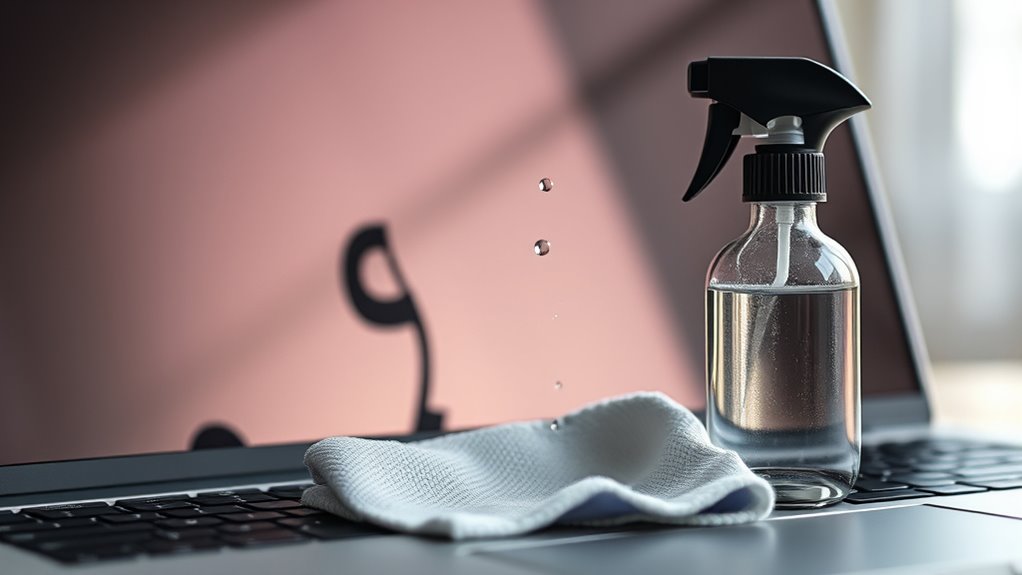To clean your laptop monitor screen, first gather high-quality microfiber cloths and distilled water. Power down your laptop and unplug it. Create a cleaning solution by mixing distilled water with a little white vinegar or use a non-toxic commercial cleaner. Dampen the microfiber cloth and wipe the screen gently in circular motions, avoiding excessive pressure. Regular upkeep helps maintain clarity. If you’re curious about other cleaning techniques, there’s more helpful information available.
Gather the Necessary Supplies
Before you begin cleaning your laptop monitor, it’s essential to gather the necessary supplies. You’ll need high-quality microfiber cloths, which are perfect for safely wiping screens without scratching them. Avoid using paper towels or rough fabrics, as they can damage the surface. Distilled water is another critical item; it’s free from minerals and impurities that could leave streaks or residue. You can also consider a gentle screen cleaner specifically designed for electronics, but keep it minimal. Confirm your workspace is clean to prevent debris from interfering with the process. Having these supplies ready will streamline your cleaning experience, allowing you to maintain your laptop monitor’s clarity and longevity with ease.
Power Down and Prepare Your Laptop
To guarantee a safe cleaning process, it’s crucial to power down your laptop completely. This not only protects the device but also assures you can clean the screen without interference from power settings or notifications. Before turning it off, save any ongoing work to prevent data loss. Once you’ve shut it down, unplug the power adapter and remove any external devices. This minimizes the risk of electric shock and avoids accidental damage during cleaning. If your laptop has a removable battery, consider taking it out as an extra safety precaution. By following these steps, you’ll create a clean slate for the upcoming cleaning process, allowing you to focus solely on getting that monitor spotless without distractions.
Choose the Right Cleaning Solution
Choosing the right cleaning solution is essential for maintaining your laptop monitor without causing damage. You have two primary options: homemade cleaners and commercial solutions. Homemade cleaners often consist of a simple mixture of distilled water and white vinegar, which can effectively cut through grime without harming the screen. Just be careful not to use too much vinegar, as it can be too harsh in concentrated amounts. On the other hand, commercial solutions specifically designed for electronics are formulated to be safe and effective. Look for those labeled as non-toxic and ammonia-free. Whichever option you choose, always apply the solution to a microfiber cloth first—never directly on the screen—to prevent moisture from seeping into your laptop.
Cleaning Techniques for Different Screen Types
Different laptop screens require specific cleaning techniques to secure ideal care while avoiding damage. For glossy screens, use a microfiber cloth slightly dampened with water or a specialized screen cleaner. Gently wipe in circular motions to prevent streaks. Avoid applying too much pressure, as this could lead to screen damage.
On the other hand, matte screens can be cleaned similarly, but they may require a bit more effort to remove fingerprints and smudges. Use a dry microfiber cloth first to lift dust, then dampen it for deeper cleaning. Always make sure the cloth isn’t too wet to avoid moisture seeping into the device. By using the right methods, you can keep both matte and glossy screens looking their best.
Maintaining a Clean Laptop Screen
Maintaining a clean laptop screen is essential for ideal viewing and device longevity. Regular screen care not only enhances your experience but also helps prevent damage. Here are three key tips for effective dust prevention:
- Use a microfiber cloth: This material effectively lifts dust and fingerprints without scratching the surface.
- Keep your workspace clean: Regularly dusting your desk can reduce the amount of debris that settles on your laptop.
- Avoid eating and drinking near your laptop: Crumbs and spills can lead to sticky residues that attract more dust.
Frequently Asked Questions
Can I Use Paper Towels to Clean My Laptop Screen?
You shouldn’t use paper towels; their abrasiveness can scratch your screen. Instead, consider microfiber cloths or specialized screen wipes, which are more effective and safer alternatives for cleaning your laptop monitor without causing damage.
How Often Should I Clean My Laptop Monitor Screen?
Think of your laptop screen like a canvas; regular screen maintenance is key. Clean it every 1-2 weeks for ideal visibility. Adjust cleaning frequency based on usage, dust exposure, and personal preference to maintain clarity.
Is It Safe to Clean While the Laptop Is On?
It’s not safe to clean while your laptop’s on. Screen safety’s essential; you risk damaging components or causing shorts. Use appropriate cleaning techniques with the device powered off for a safer, more effective clean.
What if My Screen Has Stubborn Stains?
For stubborn stains, consider using a gentle cleaning solution specifically designed for screens. Apply it to a microfiber cloth for effective stain removal, ensuring you avoid harsh chemicals that could damage your laptop’s monitor.
Can I Use Vinegar to Clean My Laptop Screen?
Using a vinegar solution to clean your laptop screen is like using a sledgehammer on a delicate sculpture—it risks damage. Opt for gentler cleaning alternatives, like microfiber cloths and distilled water, to preserve your screen’s integrity.

